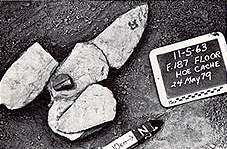[Previous] [Next] [Up] [Top]
|

Cache of Mill Creek chert hoes from
Julien site
|
Even common farmers relied an imported chert, the distinctive and fine-grained Mill Creek Chert from the Shawnee Hills, for manufacture of hoes to help clear
land and work their fields (HDYK-TECH). How was this high-quality
chert acquired? Some archaeologists suggest that the rulers of Cahokia controled this trade
in hoes through employment of craft specialists in southern
Illinois and traders to bring the finished hoes to the
American Bottom. Other researchers do not see evidence for directed trade and manufacture, arguing that each household made trips to the
Shawnee Hills to quarry the chert and manufacture their own
hoes.
|
Alternatively, some exotic tools, artifacts, and extralocal raw materials may have moved through the hands of numerous people as goods were exchanged by groups of neighbors situated between Cahokia and the place of their mining or
manufacturer. Regardless of who was involved in the trade in Mill Creek chert hoes and other exotic materials, one must wonder what was being traded for the items desired by American Bottom Mississippian people?
The locations of settlements and their size may also tell us something about how Mississippian economy functioned. In light of the Late Woodland settlement pattern consisting of numerous small villages, the Mississippian settlement pattern is rather curious. On one hand there is the growth of Mississippian centers like Cahokia, Mitchell, and Lundsford-Pulcher, apparently through the amalgamation of communities and population growth. Simultaneously, however, there was in increase in the number of farmsteads and small hamlets. It appears that some members of Late Woodland villages formed isolated family farmsteads and hamlets, while others contributed to the growth of mound-towns and mound centers. What changes in the economy are reflected by these and other changes in settlement patterns?
How were the subsistence economies of individual households and kin-groups reorganized to function in farmstead and mound center social contexts? How were populations of large centers like Cahokia fed? Were there large markets where goods from both the American Bottom as well as distant places were bought, sold, or traded? Were most people able to provide for their families with resources available in the American Bottom? Or, as some have suggested, was it necessary to import meat and animal hides into larger towns and centers around which game had long since been extirpated?
Some of the relationships in each economic sphere are personal and
concerned issues of subsistence, work, and household maintenance.
Other parts, however, relate to how social and cultural rules defined
how goods, labor, and services were controlled, accessed, and
distributed. If the chief wished to enlarge his land holdings, did he
simply take possession of someone else's field? Or did he dole out
favors, necklaces of shell beads, or offer his eldest daughter in marriage to acquire new land? What was then was the nature of the Mississippian political economy?
[Previous] [Next] [Up] [Top]
